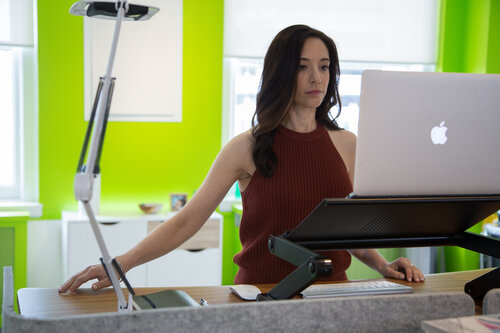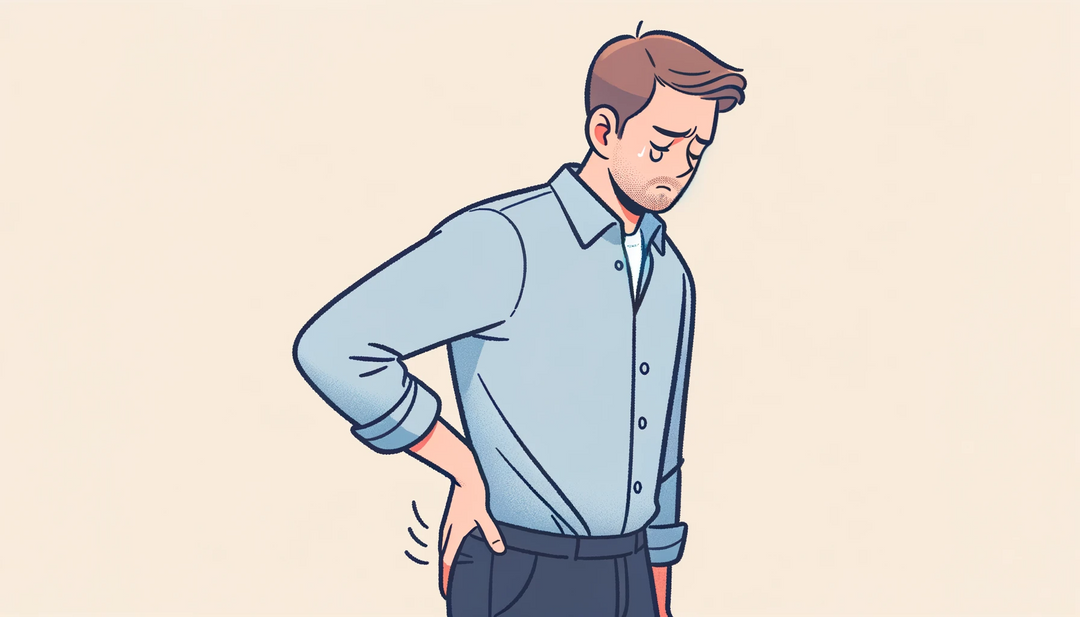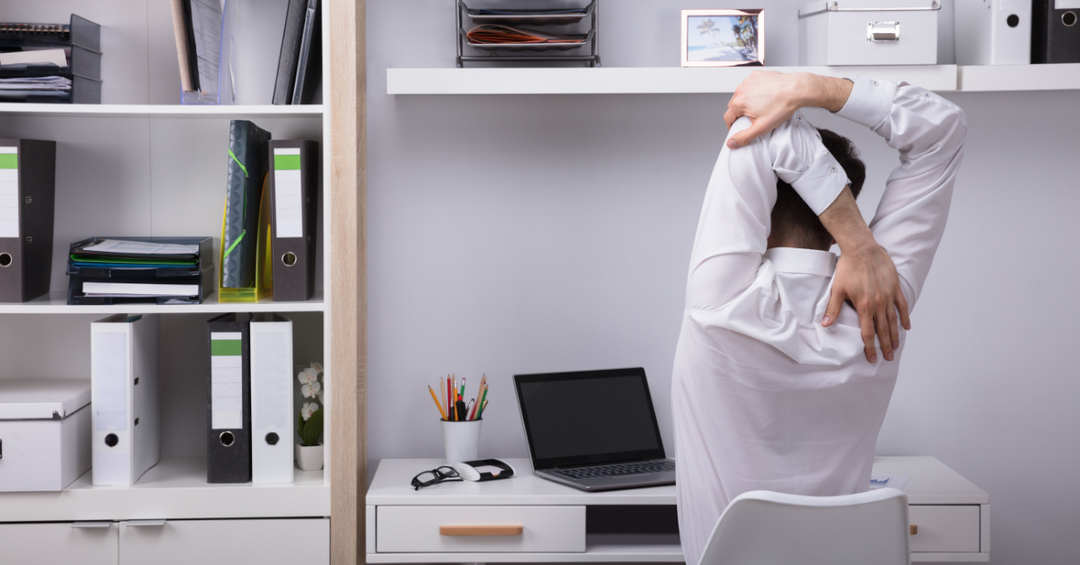Are standing desks ergonomic?

The answer may surprise you!
Does working at your standing desk make your lower back sore? Do you find your shoulders hunched forward out of mid-day fatigue? Do your feet ache by the end of the week? Did you start with a the desk, optimistic about the promised benefits of ‘productivity,’ ‘comfort,’ and ‘energy,’ but ultimately discover little or none of these things?
This struggle to find the standing desk ‘sweet spot’ is common. So common that it begs an important question... are standing desks even ergonomic?
Back to the basics: What’s ergonomics again?
Ergonomics is the study of us humans and the tools we use to live and work. The goal being: to improve our comfort, health, safety, efficiency, productivity, energy, well-being… — every aspect of our workflow. Tools like the standing desk, anti-fatigue mats, footstools, curved keyboards, vertical mice, and monitor arms are all ergonomic tools that promise to unlock these benefits.
There are three ergonomic principles that relate to standing desk use
-
Work in a comfortable (neutral) posture
-
Beat fatigue
-
Move, stretch, and take breaks
Ergonomic Principle 1: Work in a comfortable (neutral) posture
A neutral posture is a posture that is natural, comfortable, and relaxed for you — it’s a position of ease. Ergonomists sometimes call it a ‘well-balanced,’ ‘aligned,’ or ‘stacked’ posture.
Ergonomic Principle 2: Beat fatigue
Our best work comes from our best energy. Unfortunately, we all know the 2 p.m. slump too well.
Ergonomic Principle 3: Move, stretch, and takes breaks
Movement is critical for physical health. Incidentally, the primary culprit for fatigue at the desk is a lack of movement.
So... is a standing desk ergonomic? No.
Not on their own. But they ARE an important piece in the ergonomics puzzle — one that we view as more complete with an anti-fatigue mat, a raised footrest, and a standing desk chair.
Let’s look at the neutral, comfortable posture principle to start. Unfortunately, your body doesn’t fall into a neutral posture when standing. Without support, your shoulders hunch forward out of exhaustion, pulling the spine out of its neutral alignment. For most people, a perching posture — with the pelvis tilted slightly forward — is a more comfortable posture than a standing one. Recent research actually proves that a perch posture reduces low back pain because it facilitates ‘neutral spine,’ subjecting the back to less tension and stress. But a ‘perch’ isn’t possible at a standing desk without an adjustable chair to support it.

A perching posture demonstrated with our LeanRite™ Elite adjustable-height standing desk chair.
→ A good, 4-minute read on the topic of back pain: Does Sitting Cause Back Pain? Ask the TED Talk doctor!
Let’s review our goal of beating fatigue. Without anti-fatigue tools like a standing mat or footstool, your standing posture will be just as sedentary as your static one — and sedentary postures create fatigue. Simple as that.
How about our goal of taking movement and stretch breaks? The reality is if you stand for hours without support or cushion, you'll end each day tired and uncomfortable — you won't have the energy to move. And just like sitting too much, standing too much doesn't lend itself practically to movement. When you stand for long periods, you tend to zone out and lose touch with how your body feels, missing indicators that it wants to change positions or stretch (indicators like discomfort, stiffness, and pain).
A standing desk CAN be a useful ergonomic accessory by incorporating essential tools, such as an anti-fatigue mat, a footrest, and a standing desk chair
-
Anti-fatigue mat — beats fatigue through micromovement
How does it work? An anti-fatigue mat is cushiony and, therefore, unstable. When you stand on one, your muscles actively engage as they counter this cushion to maintain stability. This active engagement is micromovement, which brings activity to otherwise sedentary postures, beating fatigue by keeping the body active.
-
Footrest — allows you to change postures, staying in motion
Think of how natural it is to elevate your foot Captain-Morgan-style on the bar rail when ordering a drink. Why do we do this? Because it feels good to shift your weight and change postures regularly. With a footrest beneath your desk, you can do just this, elevating one foot at a time as comfortable — as you naturally want to. In ergo terms, this ‘postural variation’ also keeps the muscles engaged, beating fatigue, which gives you more energy to move even more.
—> Learn more: why the Ergo Impact team considers a footrest an essential accessory to every desk (~9-minute read)
-
Standing desk chair — supports not one but multiple neutral postures, sit to stand
A standing desk chair gives you support and cushion, decreasing fatigue caused by working in a standing posture. It supports multiple neutral postures so you can rotate through positions, keeping your body active and energized. With this kind of dynamic support, you can slowly build the core and leg strength needed to stand, which is the pleasant alternative to returning to the chair, tired and defeated, after a few days of effort. The option to rest in a sitting or stool height position when tired is vital for those who are relatively new to standing and need to build this strength over time. To bring these benefits full circle: because you’ll be moving more, you won’t get stuck in one position and unconsciously drain all your energy.
→ A standing desk chair is sometimes called a mobile standing chair or perching, standing height, sit-stand, height-adjustable, leaning, or active stool

The lean/perch posture is made comfortable with a cushion-style footrest which allows you to rest, flex, and stretch calves, ankles, and feet. The LeanRite™ also has a built-in anti-fatigue mat.
The key function to look for in a standing desk chair = highly adjustable

Anti-fatigue mats and footstools are relatively straightforward products. Standing desk chairs are a bit more complicated. If you’re unfamiliar with their function, check out our blog post first: What IS a Standing Desk Chair? — it gives you the basic lowdown on their design and function.
We also have one piece of advice as you’re exploring the market and seeing what’s out there: above all else, look for a highly adjustable chair. To take our LeanRite™ Elite as an example of a great ergonomic standing desk chair — both its seat pan and its height adjust. In tandem, the two components support your body in an array of postures from sit to perch to lean to stand. You can set the height at any point along its range, and the seat pan at 1 of 3 points. As you move both and try out different positions and postures, you’ll discover something brilliant: fine-tuned control over the distribution of your body’s weight across your legs and core. This fine-tuned control helps you find those postures neutral for you — the postures with maximum comfort. Because we’re all built differently, you want a chair that moves dynamically like this, so you can find the perfect support. If you’re just getting started standing, this kind of highly and easily adjustable support might be just the thing you need, so you can develop the strength and energy to stand over time.
Adjusting the LeanRite™ Elite is also very easy — there is one lever on the left side to change the seat angle and one lever on the right side to change the chair’s height. A pedal at the base also allows height adjustment by foot.
→ 3-in-1: LeanRite™ pairs perfectly with a cushion footrest and has a built-in anti-fatigue mat
-
Support and cushion LeanRite™ provides support and cushion through not one but multiple neutral postures — you can rotate through them each day, staying in motion and beating fatigue. The cushion of its built-in anti-fatigue mat also offloads the stress of standing
-
Total control over the distribution of your body’s weight Fine-tuned adjustment of the chair affords total control over the distribution of weight between your legs and core and, therefore, freedom to find multiple ‘neutral’ postures comfortable for you
-
Stretch at your desk The LeanRite™ is an excellent tool for stretching at the desk
-
Maneuverability You can adjust the LeanRite’s™ position and roll it backward or forward easily to meet your keyboard at a comfortable distance in each new position
“In a nutshell, ‘Ergonomics’ is ‘The Study of Work.’ Some people have described it as ‘designing processes, tools, and tasks that are within people’s physical abilities and limitations.’ Some say it is about productivity and efficiency, others quality, others say performance, and yet others say safety. Everyone is right.”-Tim Pottorff, QP3 ErgoSystems,
With the right accessories, a standing desk is ergonomic. Taking guidance from these ergonomic principles (and our own experience), the 3 accessories we highly recommend are an anti-fatigue mat, a footstool, and a standing desk chair. With them, you can tap into the positive benefits that good ergonomics unlocks: productivity, comfort, energy, and so much more, completing the ‘ergonomics puzzle.’







Leave a comment